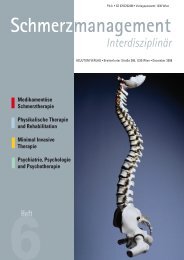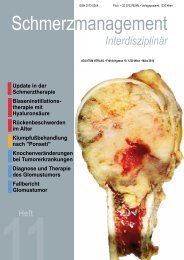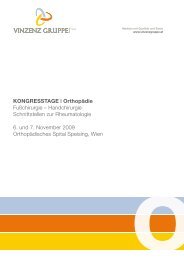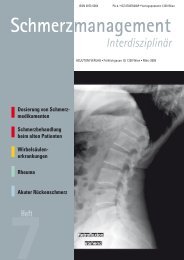Das „Medikament Bewegung“ in der Prävention von ... - Adjutum
Das „Medikament Bewegung“ in der Prävention von ... - Adjutum
Das „Medikament Bewegung“ in der Prävention von ... - Adjutum
Sie wollen auch ein ePaper? Erhöhen Sie die Reichweite Ihrer Titel.
YUMPU macht aus Druck-PDFs automatisch weboptimierte ePaper, die Google liebt.
Interdiszipl<strong>in</strong>äres Schmerzmanagement MedikaMentöse schMerztherapie<br />
Zwei Metabolite <strong>der</strong> Tryptophandegradation (Abb. 2) weisen<br />
e<strong>in</strong>en <strong>in</strong>teressanten Antagonismus auf: Kynurensäure (Kynurenic<br />
acid, KYNA) besitzt e<strong>in</strong>e neuroprotektive und antikonvulsive<br />
Potenz während Ch<strong>in</strong>ol<strong>in</strong>säure (Qu<strong>in</strong>ol<strong>in</strong>ic acid, QUIN)<br />
neurotoxische und konvulsive Eigenschaften aufweist. KYNA<br />
ist als Blocker <strong>der</strong> glutamatergen (e. g. NMDA-R) Rezeptoren<br />
und <strong>der</strong> 7α Nikot<strong>in</strong> chol<strong>in</strong>ergen Rezeptoren; dem entgegen ist<br />
QUIN als endogener Agonist <strong>der</strong> glutamatergen (e. g. NMDA-<br />
R) Rezeptoren bekannt. 1990 wurde erstmalig demonstriert,<br />
dass 3-Hydroxyanthranilsäure, die Vorstufe zur QUIN, <strong>in</strong> diversen<br />
Regionen des Rattengehirns präsent ist (Baran H. and<br />
Schwarcz R., 1990). Darüber h<strong>in</strong>aus konnte gezeigt werden,<br />
daß 3-Hydroxykynuren<strong>in</strong> und auch Anthranilsäure als Substrat<br />
für die 3-Hydroxyanthranilsäuresynthese dient (Baran H.<br />
and Schwarcz R., 1990).<br />
E<strong>in</strong>e durch Ka<strong>in</strong>säuregabe <strong>in</strong>duzierte erhöhte neuronale Aktivität<br />
bewirkte e<strong>in</strong>e signifikante Steigerung <strong>der</strong> KYNA Synthese<br />
(Baran H. et al, 1995). E<strong>in</strong>e Erhöhung des KYNA Gehaltes<br />
wurde im Gehirn bei Tieren mit generalisierten Anfällen, aber<br />
auch bei mit Ka<strong>in</strong>säure vorbehandelten Tieren ohne manifeste<br />
Krämpfe beobachtet (Baran H. et al, 1995). Aufgrund dieser<br />
Tatsache wurde auch <strong>der</strong> therapeutische E<strong>in</strong>satz <strong>von</strong> KYNA<br />
und synthetische KYNA-Analoga zur Behandlung <strong>von</strong> Epilepsien<br />
und an<strong>der</strong>en Gehirnerkrankungen <strong>in</strong> Betracht gezogen,<br />
allerd<strong>in</strong>gs darf nicht vergessen werden, dass KYNA durch<br />
se<strong>in</strong>e blockierende Wirkung an NMDA-Rezeptoren und an<br />
den α7 Nikot<strong>in</strong> chol<strong>in</strong>ergen Rezeptoren auch unerwünschte<br />
Nebenwirkungen, wie Sedierung und schlechtere Reizverarbeitung<br />
verursachen kann (Carpenedo et al., 1994; Chess und<br />
Bucci, 2006).<br />
Abb. 2. Tryptophanmetabolismus entlang<br />
des „Kynuren<strong>in</strong>pathways“.<br />
Der E<strong>in</strong>fluss <strong>der</strong> Antiepileptika auf die KYNA–Synthese wurde<br />
<strong>in</strong> <strong>in</strong> vitro Studien untersucht (Kocki et al., 2006): Phenobarbital,<br />
Phenyto<strong>in</strong>, Felbamat und Lamotrig<strong>in</strong> erhöhen die KYNA-<br />
Synthese, während Vigabatr<strong>in</strong>, Gabapent<strong>in</strong> und Tiagab<strong>in</strong>e die<br />
KYNA-Synthese hemmten. Diazepam und Midazolam hatten<br />
<strong>in</strong> <strong>in</strong> vitro Studien ke<strong>in</strong>en E<strong>in</strong>fluss auf die KYNA-Synthese.<br />
<strong>Das</strong>s KYNA durch ihre Wirkung an NMDA und Nikot<strong>in</strong> chol<strong>in</strong>erge<br />
Rezeptoren auch e<strong>in</strong>e Wirkung auf kognitive Funktionen<br />
ausüben kann, limitiert den E<strong>in</strong>satz <strong>der</strong> KYNA bzw. <strong>der</strong><br />
KYNA Analoga. Heyl<strong>in</strong>ger et al. stellten 1999 unter an<strong>der</strong>em<br />
fest, dass KYNA analgetische Eigenschaften besitzt. Schwieler<br />
et al. demonstrierten 2005 <strong>in</strong> e<strong>in</strong>er Studie mit Ratten, dass die<br />
zerebrale Steuerung <strong>der</strong> KYNA-Synthese wahrsche<strong>in</strong>lich über<br />
Prostagland<strong>in</strong>e vermittelt wird. Die nicht-selektiven Cyclooxygenasehemmer<br />
Diclofenac und Indomethac<strong>in</strong>, die e<strong>in</strong>e bevorzugte<br />
Hemmung <strong>der</strong> COX-1 aufweisen, erhöhten die KY-<br />
NA-Konzentration im Gehirn. Selektive COX-2 Hemmer, wie<br />
Parecoxib o<strong>der</strong> Meloxicam erniedrigten im Gegensatz dazu<br />
die zerebrale KYNA-Konzentration. Beide Verän<strong>der</strong>ungen<br />
konnten durch die Gabe <strong>von</strong> Misoprostol, e<strong>in</strong>em Prostagland<strong>in</strong>agonisten,<br />
aufgehoben werden (Schwieler et al., 2005). Diese<br />
Tatsache lässt vermuten, dass sowohl die durch COX-1<br />
Hemmer hervorgerufene Analgesie, als auch die vor allem bei<br />
Indomethac<strong>in</strong> beobachteten zentralen Nebenwirkungen, wie<br />
Psychosen, Wahnvorstellungen und kognitive Dysfunktionen,<br />
zum<strong>in</strong>dest teilweise durch den gesteigerten KYNA-Metabolismus<br />
hervorgerufen werden (Hoppmann et al., 1991). Auch <strong>der</strong><br />
NMDA- und <strong>der</strong> α7 Nikot<strong>in</strong> chol<strong>in</strong>erge Rezeptorblocker Memant<strong>in</strong><br />
zeigt im <strong>in</strong> vitro Modell e<strong>in</strong>en steigernden Effekt auf<br />
die KYNA-Synthese. Neuerd<strong>in</strong>gs wird untersucht, ob Memant<strong>in</strong><br />
als Intervallbehandlung bei Migräne wirksam ist. Ketam<strong>in</strong><br />
(MK-801), e<strong>in</strong> NMDA-Rezeptorantagonist, zeichnet sich bei<br />
<strong>in</strong>trathekaler Gabe durch e<strong>in</strong>en mit KYNA vergleichbaren Effekt<br />
aus. Ob e<strong>in</strong>e Erhöhung des zerebralen/sp<strong>in</strong>alen KYNA Levels<br />
bei Gabe <strong>von</strong> Ketam<strong>in</strong> e<strong>in</strong>tritt, ist bis dato unbekannt.<br />
1, 2<br />
Verfasser: Univ.-Prof. Dr. Hal<strong>in</strong>a Baran<br />
1Abteilung für Neurophysiologie, Institut für Physiologie, Department für<br />
Biomediz<strong>in</strong>ischen Wissenschaften, Veter<strong>in</strong>ärmediz<strong>in</strong>ische Universität Wien,<br />
2Neurochemisches Forschungslabor, Karl Landste<strong>in</strong>er Institut für Schmerztherapie<br />
und Neurorehabilitation, NÖ Landeskl<strong>in</strong>ikum Mauer-Amstetten.<br />
Referenz:<br />
1. Baran H., Sperk G., Hörtnagl H. and O. Hornykiewicz (1982) Inhibition of ka<strong>in</strong>ic acid <strong>in</strong>duced<br />
convulsions by clonid<strong>in</strong>e <strong>in</strong> the rat. Naunyn-Schmiedeberg‘s Arch. Pharmacol. Suppl. 321, R.43.<br />
2. Baran H., Sperk G., Hörtnagl H., Sapetschnig G. and O. Hornykiewicz (1985) a2-Adrenoceptors<br />
modulate ka<strong>in</strong>ic acid-<strong>in</strong>duced limbic seizures. Eur. J. Pharmacol., 113, 263-269.<br />
3 . Baran H., Heldt R. and G. Hertt<strong>in</strong>g (1987) Increased prostagland<strong>in</strong> formation <strong>in</strong> rat bra<strong>in</strong> follow<strong>in</strong>g<br />
systemic application of ka<strong>in</strong>ic acid. Bra<strong>in</strong> Res., 404, 107-112.<br />
4. Baran H, Hörtnagl H. and O. Hornykiewicz (1989) Ka<strong>in</strong>ic acid-<strong>in</strong>duced seizures: potentiation by<br />
a-methyl -p-tyros<strong>in</strong>e. Bra<strong>in</strong> Res., 495, 253-260.<br />
5. Baran H. and R. Schwarcz (1990) Presence of 3-hydroxyanthranilic acid <strong>in</strong> rat tissue and evidence<br />
for its production from anthranilic acid <strong>in</strong> the bra<strong>in</strong>. J. Neurochem., 55, 738-744.<br />
6. Baran H., Okuno E., Kido R. and R. Schwarcz (1994) Purification and characterization of kynuren<strong>in</strong>e<br />
am<strong>in</strong>otransferase I from human bra<strong>in</strong>. J. Neurochem., 62, 730-738.<br />
7. Baran H., Vass K., Lassmann H. and O. Hornykiewicz (1994) The cyclooxygenase and lipoxygenase<br />
<strong>in</strong>hibitor BW755C protects rats aga<strong>in</strong>st ka<strong>in</strong>ic acid-<strong>in</strong>duced seizures and neurotoxicity. Bra<strong>in</strong> Res.,<br />
646, 201-206.<br />
8. Baran H., Gramer M., Hönack D. and W. Löscher (1995) Systemic adm<strong>in</strong>istration of ka<strong>in</strong>ate <strong>in</strong>duces<br />
marked <strong>in</strong>crease of endogenous kynurenic acid <strong>in</strong> various bra<strong>in</strong> regions and plasma of rats. Eur. J.<br />
Pharmacol., 286, 167-175.<br />
9. Birch P.J., Grossman C.J. and Hayes A.G. (1988) Kynurenic acid antagonizes responses to NMDA via<br />
an action at the strychn<strong>in</strong>e-<strong>in</strong>sensitive glyc<strong>in</strong>e site. Eur. J. Pharmacol., 154, 85-87.<br />
10. Carpenedo R., Chiarugi A., Russi P., Lombardi G., Carlà V., Pellicciari R., Mattoli L. and Moroni<br />
F. (1994) Inhibitors of kynuren<strong>in</strong>e hydroxylase and kynuren<strong>in</strong>ase <strong>in</strong>crease cerebral formation of<br />
kynurenate and have sedative and anticonvulsant activities. Neurosc<strong>in</strong>ce 61, 237-244.<br />
11. Chess A.C. and Bucci D.J. (2006) Increased concentration of cerebral kynurenic acid alters stimulus<br />
process<strong>in</strong>g and conditioned respond<strong>in</strong>g. Behav. Bra<strong>in</strong> Res. 170, 326-332<br />
12. Baran H., Keppl<strong>in</strong>ger B. and H. Hörtnagl (2000) Clonid<strong>in</strong>e modulates the BAY K 8644 <strong>in</strong>duced<br />
behavior and neurotransmitter changes <strong>in</strong> the rat bra<strong>in</strong>. Eur. J. Pharmacol, 401, 1, 31-37.<br />
13. Carpenedo R., Chiarugi A., Russi P., Lombardi G., Carlà V., Pellicciari R., Mattoli L. and Moroni<br />
F. (1994) Inhibitors of kynuren<strong>in</strong>e hydroxylase and kynuren<strong>in</strong>ase <strong>in</strong>crease cerebral formation of<br />
kynurenate and have sedative and anticonvulsant activities. Neuroscience 61, 237-244.<br />
14. Heyl<strong>in</strong>ger S.O., Goodman C.B., Ngong J.M. and Soliman K.F.A. (1999) The analgesic effects of<br />
tryphtophan and its metabolites <strong>in</strong> the rat. Pharmacology Res., 38, 243-250.<br />
15. Hoppmann R.A., Peden J.G. and Ober S.K. (1991) Central nervous system side effects of non-steroidal<br />
anti-<strong>in</strong>flammatory drugs. Aseptic men<strong>in</strong>gitis, psychosis and cognitive dysfunction. Arch. Int.<br />
Med., 151, 1309-1313.<br />
16. Kocki T., Wielosz M., Turski W.A. and Urbanska E.W. (2006) Enhancement of bra<strong>in</strong> kynurenic acid<br />
production by anticonvulsants – novel mechanism of antiepileptic activity? Eur. J. Pharmacology,<br />
541, 147-151.<br />
17. Schwieler L., Erhardt S., Erhardt C. and Engberg G. (2005) Prostagland<strong>in</strong>-mediated control of<br />
rat bra<strong>in</strong> kynurenic acid synthesis – opposite actions by COX-1 and COX-2 isoforms. J. Neural.<br />
Transm., 112, 863-872.<br />
11




![Download [PDF] - Adjutum](https://img.yumpu.com/42536911/1/184x260/download-pdf-adjutum.jpg?quality=85)



![Download [PDF] - Adjutum](https://img.yumpu.com/31084679/1/184x260/download-pdf-adjutum.jpg?quality=85)






